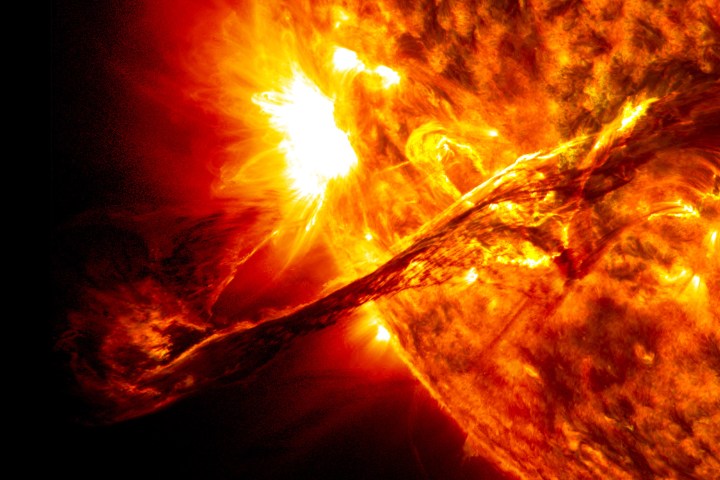
These things are devastating. According to experts, a powerful flare could knock out satellite communications and electrical grids, take the internet offline, and bring the world to a sudden halt.
Some scientists think the Sun poses one of the biggest threats to humanity; in a single solar flare, the typically life-giving orb could become the source of our demise. Now, a study out of Harvard University puts that risk in perspective, suggesting that such an event could smack Earth in the next century.
Not if, but when
Solar flares happen often – they just don’t always impact Earth. Scientists think a solar event nearly sparked World War III. A huge flare called the Carrington event erupted 150 years ago, and caused auroras to paint the sky in technicolor as far south as Cuba and Hawaii. Pretty cool, right? Well it wasn’t so cool for telegraph operators worldwide who were physically shocked by spark discharges before their machines burst into flames. If the Carrington event occurred today, we can strap in for a for digital silence, if not the techpocalypse.
A powerful flare could bring the world to a halt.
Luckily, there may be hope, as the researchers also offered an idea: put a massive magnet between us and the Sun.
Conducted by Harvard’s Avi Loeb and Manasvi Lingam, the study found that the most intense solar flares erupt from stars like ours approximately every 20 million years. We would be lucky to just lose cell service in an event like this, which could peel back our ozone layer and even mutate the DNA of most living organisms. Planet Earth, as we know it, would be changed forever.
A solar storm of that magnitude is unlikely to occur soon, but the researchers warn that we should be prepared for one similar to the Carrington event. Loeb told Digital Trends such an event would “damage power grids, satellites, and cause a breakdown of global supply chains.”
In fact, in 2012 NASA announced that a solar superstorm, comparable to the Carrington event, missed Earth by about nine days. Had the storm hit our planet, the global economic cost would have been up to $2.6 trillion, with recovery taking between four to ten years, according to a study from University of California, Berkeley and China’s State Key Laboratory of Space Weather.
The solution? Magnets. Gigantic magnets. In space.
In order to mitigate the risk of such an event, Loeb and Lingam have proposed a magnetic deflector in the form of a huge loop of conductive wire that would be positioned between Earth and the Sun. If and when an Earth-threatening solar flare occurs, the loop would act as a shield to repel harmful particles.
“The basic idea is to place a current loop between the Sun and the Earth that supplies sufficient magnetic field to deflect the incoming charged particles from the Sun,” Lingam said. “The shield appears to be feasible even within the limits of our current technology, although it would undoubtedly be a costly undertaking.”
But there is, naturally, a catch. The loop would weigh in at around 100,000 tons, according to the researchers’ calculations, and would cost some $100 billion to launch. That’s about the price of the International Space Station.
“I think that seriously diverting resources to build a wire loop in space would not be the best way to spend money,” Greg Laughlin, an astrophysicist at Yale University, told New Scientist. “But thinking more about how solar super flares work and getting a sense of how our Sun fits in with its peers would be a very valuable effort.”
Before dropping $100 billion on a massive space loop, there are things we can do here on Earth, such as making our technology less vulnerable, “by shielding it or placing it underground or having back-up systems,” says Loeb “More planning needs to be done at an international level, similarly to the political coordination regarding climate change.”
So, just as the United Nations recently sanctioned International Asteroid Day to raise awareness about impacts, maybe it’s time we pay closer attention to the Sun and prepare for its flares.


